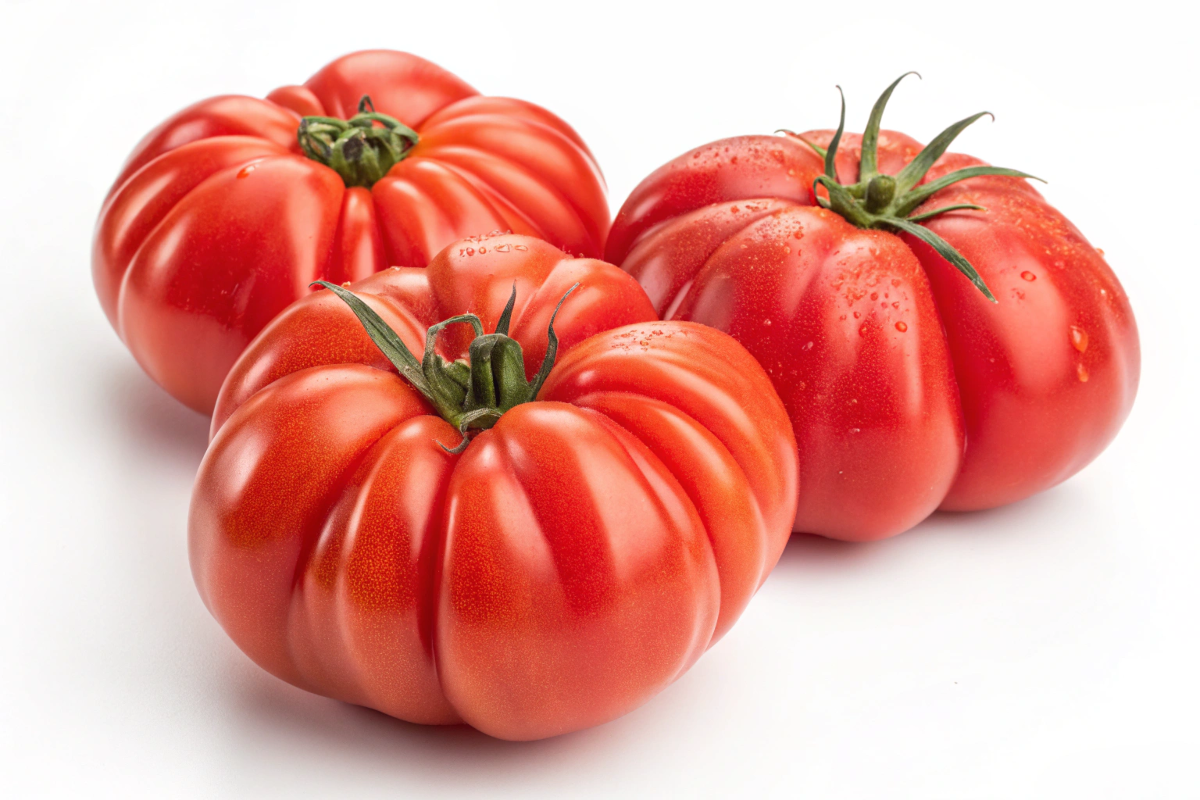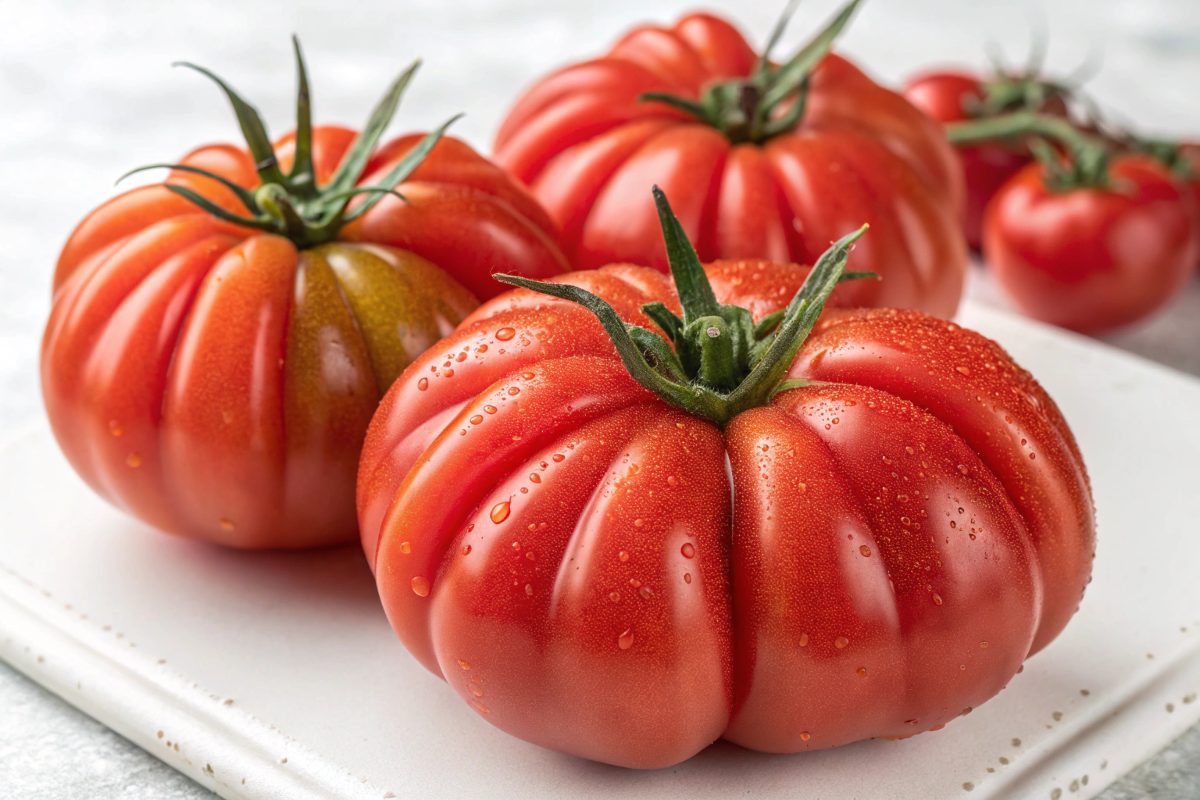Beef tomatoes are among the most versatile and nutrient-packed fruits you can add to your diet or garden. With their rich history, exceptional flavor, and health benefits, they are a favorite for culinary and gardening enthusiasts alike. This guide explores everything you need to know about steak tomatoes—their history, characteristics, nutritional value, health benefits, and more.
What is a Beef Tomato?
The steak tomatoes is a remarkable variety of tomato known for its size, taste, and adaptability in the kitchen. Unlike smaller tomato varieties, beef tomatoes are meaty, flavorful, and have fewer seeds, making them perfect for slicing, stuffing, or cooking into sauces. Their robust structure holds up well in sandwiches, salads, and baked dishes.
Origins and History of the Beef Tomato
Meaty Tomatoes, like all tomatoes, originated in the Andes region of South America. Indigenous peoples first cultivated wild tomato varieties, which spread to Europe in the 16th century. Farmers in Italy and Spain began breeding larger, meatier tomatoes, leading to the modern-day beef tomato. Today, they are grown in home gardens and commercial farms worldwide, celebrated for their versatility and flavor.
Characteristics of Beef Tomatoes
Understanding what makes Meaty Tomatoes unique can help you appreciate their value. Key features include:
- Size and Shape: Large, round, and slightly flattened at the top.
- Texture: Firm, with a meaty interior and minimal seeds.
- Flavor: Sweet with a slight tang, making them ideal for various dishes.
- Adaptability: Perfect for grilling, stuffing, or using as a base for sauces.
Now that we’ve explored what makes steak tomatoes special, let’s delve into the nutritional profile that makes them such a healthy choice.
Nutritional Value of Beef Tomatoes
Steak tomatoes are not only delicious but also packed with nutrients that support a healthy lifestyle. They are low in calories, rich in hydration, and loaded with vitamins and minerals.
Macronutrients in Beef Tomatoes
Beef tomatoes offer a balanced combination of macronutrients, including:
- Carbohydrates: Provide energy for daily activities.
- Dietary Fiber: Aids digestion and promotes gut health.
- Low Fat Content: Ideal for those managing calorie intake.
Their hydration benefits come from a water content of over 90%, helping you stay refreshed.
Vitamins and Minerals in Beef Tomatoes
Rich in essential nutrients, steak tomatoes are a powerhouse for health:
- Vitamin C: Boosts immunity and protects cells from damage.
- Potassium: Regulates heart and muscle functions.
- Lycopene: A key antioxidant that gives tomatoes their red hue and protects against oxidative stress.
- With such a robust nutritional profile, it’s no surprise that beef tomatoes offer significant health benefits. Let’s take a closer look at how they can improve your well-being.

Health Benefits of Eating Beef Tomatoes
Adding beef tomatoes to your diet can positively impact your heart, skin, and immune system. These health benefits stem from their unique combination of antioxidants, vitamins, and minerals.
Promoting Heart Health
The potassium and lycopene found in meaty tomatoes work together to support cardiovascular health. Benefits include:
- Reducing blood pressure through potassium regulation.
- Preventing plaque buildup in arteries.
- Lowering the risk of heart disease with lycopene’s antioxidant properties.
Enhancing Skin Health
Steak tomatoes contribute to a youthful and healthy complexion. Their Vitamin C content promotes:
- Collagen production for firmer skin.
- Protection against harmful UV rays.
- A reduction in redness and inflammation.
Lycopene further aids in repairing damaged skin and slowing signs of aging.
Boosting Immune Function
Packed with immune-boosting nutrients, beef tomatoes help your body fight infections and recover faster. Regular consumption supports:
- Stronger immunity with Vitamin C.
- Reduced inflammation with antioxidants.
- Enhanced recovery from colds and flu.
Equipped with an understanding of their health benefits, you might wonder how to enjoy meaty tomatoes in your meals or even grow them at home. Let’s continue exploring their practical uses and growing tips in the next section.
Culinary Applications of Steak Tomatoes
Beef tomatoes, with their succulent texture and mild sweetness, are a favorite in kitchens worldwide. Their versatility makes them indispensable in classic recipes, creative pairings, and beginner-friendly dishes. Whether raw or cooked, they add a rich, wholesome flavor that elevates any meal.
Timeless Dishes Highlighting Steak tomatoes
- Traditional Italian Caprese Salad: Layered beef tomato slices with mozzarella and basil for a refreshing starter.
- Stuffed Beef Tomato Entrées: Hollowed-out tomatoes filled with seasoned rice, meat, or vegetables.
- Rustic Beef Tomato Stew: Slow-cooked with beef chunks, onions, and carrots for a hearty family meal.
- Fresh Sandwich Enhancer: Thick slices of beef tomato on burgers or BLTs for added juiciness.
These dishes demonstrate how beef tomatoes can take center stage or act as the perfect complement to a recipe.
Pairing Juicy Beef Tomatoes with Other Ingredients
- Combine with garlic, olive oil, and herbs to craft a savory pasta sauce.
- Mix with soft cheeses like ricotta or cream cheese for balanced flavors.
- Grill alongside zucchini and mushrooms for a smoky summer medley.
- Pair with lean proteins, like grilled chicken or tofu, for a nutritious meal.
The natural sweetness and slight acidity of meaty tomatoes make them an ideal partner for a wide variety of ingredients.
Simple Beef Tomato Recipes for New Cooks
- Quick Tomato Basil Salad: Toss diced beef tomatoes with olive oil, salt, and fresh basil.
- Easy Tomato Soup: Blend roasted beef tomatoes, garlic, and broth for a creamy dish.
- Stuffed Tomatoes for Beginners: Fill tomatoes with couscous or quinoa and bake until tender.
- Pasta with Fresh Tomato Sauce: Sauté chopped beef tomatoes with onions and olive oil for a fast, flavorful topping.
These recipes require minimal ingredients but highlight the rich, natural taste of beef tomatoes.
With their culinary versatility established, let’s turn to the joy of growing beef tomatoes at home to ensure a fresh, constant supply.

Cultivating Steak tomatoes at Home
Home-grown beef tomatoes are unmatched in flavor and freshness. Cultivating these hearty fruits is easier than you might think, with just a few essential steps to ensure a healthy harvest.
Choosing Ideal Seeds and Fertile Soil for Beef Tomatoes
- Select heirloom or hybrid seeds known for producing plump, juicy tomatoes.
- Opt for soil rich in organic matter, with good drainage to prevent waterlogging.
- Use a pH-balanced soil (6.0–6.8) to encourage optimal growth.
Starting with quality seeds and nutrient-rich soil ensures strong, healthy plants.
Planting Techniques and Proper Watering for Beef Tomatoes
- Begin seeds indoors and transplant seedlings outdoors after the last frost.
- Plant in a sunny location with 2–3 feet between each plant for sufficient airflow.
- Water consistently, keeping the soil moist but not overly saturated.
Regular watering and spacing create the perfect environment for thriving plants.
Safeguarding Against Pests and Diseases in Beef Tomato Plants
- Use companion plants, like basil or marigold, to deter pests like aphids and hornworms.
- Rotate crops annually to prevent diseases such as early blight or root rot.
- Inspect plants weekly and use organic pesticides when necessary.
Preventative measures help keep your plants healthy and your harvest bountiful.
Once your steak tomatoes are ready, choosing the perfect ones for your meals is key. Let’s explore how to recognize quality and maintain freshness.
Selecting the Best Beef Tomatoes for Your Kitchen
Choosing the perfect meaty tomatoes involves a keen eye for ripeness and proper storage to retain their vibrant flavors.
Determining Ripeness and Premium Quality in Beef Tomatoes
- Look for tomatoes with uniform color, free from blemishes or cracks.
- Ripe beef tomatoes should feel firm but slightly soft to the touch.
- Smell the tomato near the stem; a sweet, earthy aroma indicates ripeness.
Picking high-quality tomatoes ensures maximum flavor for your dishes.
Storing Beef Tomatoes for Extended Freshness
- Store at room temperature for the best flavor; refrigeration should be avoided unless overripe.
- Keep partially ripe tomatoes in a paper bag to speed up ripening.
- Use ripe tomatoes within 3–4 days for optimal taste.
Proper storage methods preserve the freshness and natural sweetness of your tomatoes.
Beyond individual kitchens, meaty tomatoes hold a global appeal. Let’s uncover how they are celebrated and adapted around the world.
Steak Tomatoes Across the Globe
Beef tomatoes, with their universal appeal, play a significant role in cuisines and cultures worldwide. Their size and flavor make them ideal for regional specialties and festive occasions.
Distinct Regional Varieties of Beef Tomatoes
- In Italy, varieties like Costoluto Fiorentino are prized for pasta sauces.
- Mexico incorporates beef tomatoes into traditional salsas and soups.
- In the U.S., hybrids such as Big Beef are grown for their disease resistance and flavor.
Each region’s varieties reflect local preferences and culinary traditions.
Cultural Importance and Celebrations Featuring Beef Tomatoes
- Italy’s Tomatina Festival celebrates the tomato with food fights and feasts.
- In Japan, beef tomatoes are used in fresh, light dishes like salads or sushi garnishes.
- The U.S. showcases beef tomatoes at farmers’ markets and agricultural fairs.
Beef tomatoes serve not only as a staple ingredient but as a symbol of cultural pride.
From global celebrations to individual plates, steak tomatoes bring a sense of tradition and versatility that no other fruit can match.

Frequently Asked Questions About Beef Tomatoes
Meaty tomatoes are a favorite among culinary enthusiasts for their unique characteristics and versatility. Let’s explore the most common questions about these delicious fruits and why they deserve a spot in your kitchen.
What Sets Beef Tomatoes Apart From Other Tomato Varieties?
Seak tomatoes, also called steak tomatoes, distinguish themselves with their substantial size, firm texture, and versatility in cooking. Unlike their smaller counterparts, they are:
- Larger and heavier, making them perfect for slicing.
- Less watery, which makes them ideal for sauces, grilling, and stuffing.
- Mildly sweet with a balanced acidity, giving them a distinct yet versatile flavor profile.
These qualities make steak tomatoesa must-have for recipes requiring a hearty, robust tomato. Transitioning to their consumption, let’s explore whether you can enjoy these giants raw.
Can You Enjoy Beef Tomatoes Raw?
Absolutely! Beef tomatoes are a delight when eaten raw due to their naturally mild flavor and juicy yet firm texture. They are perfect for:
- Adding a refreshing crunch to salads.
- Enhancing sandwiches and burgers with their thick, satisfying slices.
- Combining with fresh mozzarella, basil, and olive oil for a quick Caprese salad.
To maximize their raw flavor, choose ripe beef tomatoes with smooth skin and a deep red hue. Speaking of suitability, let’s find out if they align with all dietary preferences.
Are Beef Tomatoes Suitable for Various Diets?
Yes, beef tomatoes are highly adaptable and fit well into a variety of diets. They are:
- Low in calories, making them great for weight-conscious individuals.
- Rich in nutrients like Vitamin C, potassium, and antioxidants, supporting overall health.
- Naturally free of gluten and animal products, catering to gluten-free and plant-based diets.
However, those with specific allergies to tomatoes or nightshade plants should consult a healthcare professional. Moving forward, let’s discuss the optimal conditions for growing these versatile fruits.
How Do You Grow Beef Tomatoes Successfully?
Growing meaty tomatoes at home is rewarding if you follow these key steps:
- Soil Preparation: Use nutrient-rich, well-drained soil to support healthy root development.
- Sunlight: Ensure your plants get at least 6-8 hours of direct sunlight daily.
- Watering: Water consistently but avoid overwatering to prevent rot.
Support the heavy fruit with sturdy cages or stakes to protect the plants as they grow. With proper care, your garden can yield an abundant supply of these versatile fruits. Ready to enjoy them long after the harvest? Let’s talk about preservation methods.
How Can You Preserve Beef Tomatoes for Long-Term Use?
To enjoy the rich flavor of beef tomatoes year-round, use these preservation tips:
- Refrigeration: Store ripe tomatoes in the fridge to slow further ripening.
- Freezing: Chop or puree the tomatoes and freeze them in airtight containers.
- Canning: Preserve them as sauces or whole in jars for use in soups and stews.
- Drying: Slice and dry them for flavorful additions to salads and pastas.
Preservation not only extends their usability but also minimizes food waste. As we explore sustainability, let’s address a common concern about steak tomatoes being genetically modified.
Are Meaty Tomatoes Genetically Modified?
Most beef tomatoes available on the market are not genetically modified (non-GMO). They are the result of traditional cultivation techniques, selected for their size and flavor.
- Look for labels such as “non-GMO” or “organic” if you’re concerned about genetic modification.
- Purchase from farmers’ markets for naturally grown options and to support local agriculture.
Understanding the source of your produce helps you make informed decisions. Now that we’ve covered all the FAQs, let’s summarize why steak tomatoes are an essential addition to your lifestyle.
Conclusion
Meaty Tomatoes bring more than just flavor to the table—they offer a wealth of benefits:
- They are versatile and can elevate both raw and cooked dishes.
- Packed with nutrients, they support various dietary needs while being low in calories.
- Easy to grow, preserve, and enjoy year-round, they’re a sustainable choice for home cooks.
Incorporating beef tomatoes into your meals can enhance your health and add a burst of flavor to your recipes. With so many reasons to love them, it’s time to make these juicy giants a staple in your kitchen.


5 thoughts on “Beef Tomatoes: FAQs, Benefits, and Tips for Growing and Cooking”